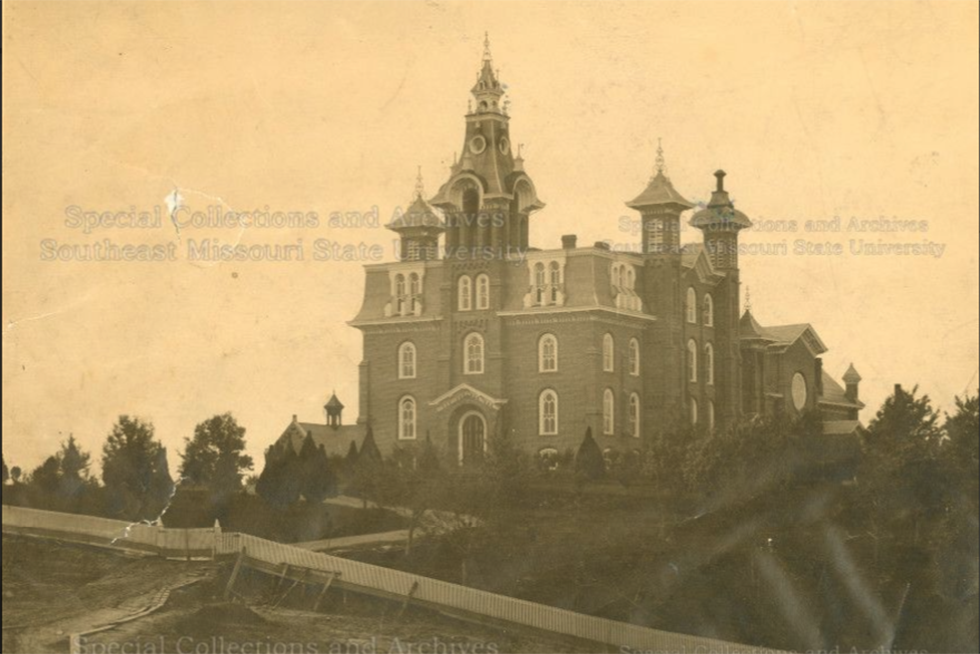1873-1879
Continue to main content
1873
March 22
The Missouri Legislature votes and Gov. Silas Woods signs a bill to establish a Third District Normal School in southeast Missouri.
April 19
Cape Girardeau County holds its first meeting to attempt to win the location of the new normal school.
October 1873
The Executive Committee of the Board of Regents selects Professor L.H. Cheney as the Normal School’s first principal. Under Cheney’s administration, classes began, the Normal building was constructed, and a curriculum was created.
October 27
The Board of Regents by a 4-3 vote agrees to locate the Southeast Missouri Normal School in Cape Girardeau over a bid from Iron County to locate the school in Arcadia. Cape Girardeau bid $54,865 for the school, while Iron County bid $50,608. The Board visited both locations before making its decision.
"The Board of Regents expresses concern about the City of Cape Girardeau’s financial status and its ability to sell bonds for the Third District Normal School due to its extensive railroad debt. The Board said the school would go to Arcadia if the bonds were not sold. Within 30 minutes, Cape Girardeau citizens Otto Buehrmann and Col. Robert Sturdivant agree to underwrite the bonds, and just nine months after the decision to establish a third normal school in the state, the Southeast Missouri Normal School finds its home in Cape Girardeau."
December 1, 1873

December 1873
The Third District Normal School opens in a temporary location in Lorimier School while the Normal School is being constructed.
December 1
The Board of Regents selects Fort B as the site of the new Normal School. Joseph Lansmon, a German immigrant and builder who owns the hill, donates the building site and sells an additional 10 adjoining acres for $1,000 at the request of the Board.
1874
January 14
Building plans by J.B. Clarke of St. Louis are accepted for the Normal School.
March 1874
The Board of Regents accepts a $39,000 bid from W.E. Gray from Alton, Illinois, for construction of the Normal School.
Summer 1874
Cape Girardeau citizen and brick layer Lemuel Randol was killed by lightning at the building site of the Third District Normal School.
1875
April 21
The new building for the Southeast Missouri Normal School – a red brick Gothic structure -- is completed and accepted by the Board of Regents and the state.
Societies are created with the first, organized by faculty, being the Union Literary, Humbolt Natural History and Arion Musical. Two student-formed societies, Adelphia and Zenonia Societies, later replaced the three faculty-created societies.
The Normal School gives diplomas for the first time for a two-year course of study.
1876
Third District Normal School Principal and Professor L.H. Cheney dies while doing geological work as part of a Harvard University summer field camp at Cumberland Gap, Tennessee. A mound he was excavating collapsed and crushed him. He was buried in Lorimier Cemetery in Cape Girardeau.
The Executive Committee of the Board of Regents selects Alfred Kirk as the second principal of the Normal School. He remained in the position less than nine months.
1877
Summer 1877
Professor C.H. Dutcher becomes the third principal of the Normal School. During Dutcher’s administration, enrollment increased for two consecutive years and summer institutes were created for area teachers to increase their qualifications.
Southeast Missouri Normal School’s first commencement for four-year study took place in 1877. Emma E. Cowden was the first to finish the school’s four-year program.
1878
Students can take classes in six departments, including Professional, Mathematics, English Language and Literature, Natural Sciences and Physics, Geography and History, and Art.
January 1878
Long distance telephone service becomes operational in Cape Girardeau County.
1879
Students must possess “good moral character” for admission.
World Events
May 1873
Blue jeans are invented
1874
The Little Rock Express on the Iron Mountain Railroad was robbed by what was believed to be the work of the James Gang. It became Missouri’s first train robbery.
1876-1914
The Gilded Age marks a massive expansion in wealth, territory, population and industry in the United States.